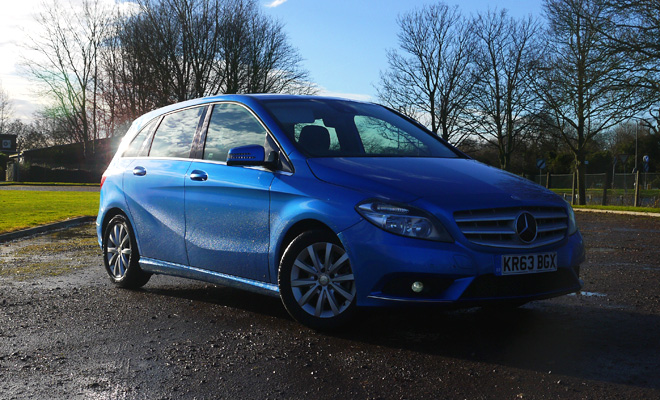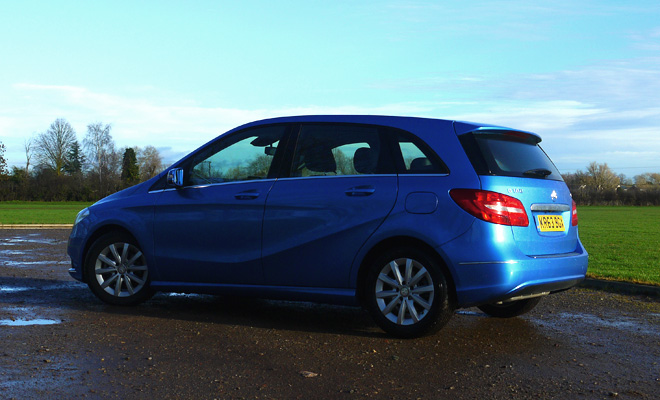by Lem Bingley 
Fortunately the six-speed gearbox fitted to the Mercedes B-Class is more obliging than the manual option I struggled with in its C-Class big brother and so, encouraged by the horns of my fellow motorists, I was able to work out that a simple lift of the stick will unlock the reverse slot.

If I were spending my own money I think I’d want an automatic B-Class, but the manual box is part and parcel of the most economical edition of the car – the B180 CDI Eco SE. Newly arrived for 2014, the Eco edition employs a top-hat full of tricks to cut its CO2 score down from 108g/km for the standard B180 diesel to just 98g/km. Fleet managers might prefer 95g/km or less for tax reasons, and for that they can now choose an Eco edition of the lower and leaner A-Class. The A180 CDI Eco SE, sister car to today’s test vehicle, hits an impressive 92g/km, down from 98g/km.
The A-Class outsells the B-Class by about 7 to 1, not least because it’s noticeably cheaper, but I still have a soft spot for the more boxy and upright of the two cars. It’s not really the versatile MPV its shape suggests, but it is a roomy and comfortable hatchback with a persuasive air of quality about it.

The Eco B-Class certainly scores over the average A-Class in ride comfort, providing an almost pillowy ride despite suspension that’s been lowered 20mm at the front and 15mm at the rear. Hunkering closer to the ground aids aerodynamics, squishing a lower volume of air under the body at speed and reducing the car’s effective frontal area. Flat underbody panelling also encourages the air to slip under the car like a greased eel.
Relatively tall 205/55 tyres on 18-inch alloys no doubt also contribute to the car’s gentle nature. Ruts and ridges won’t ever set your jawbone clacking, though the height of the B-Class does occasionally see the body succumb to a rolling, see-sawing motion over particularly uneven surfaces. It won’t quite make you seasick but it may make you ease off a little more than you otherwise might on an undulating B-road.

Apparently the gearbox’s higher ratios have also been lengthened in the Eco edition, to keep the engine turning more modestly at high speeds. I’d like to say by how much, but specs provided by Mercedes unexpectedly listed ratios identical to the standard B180 CDI. Ears, eyes and backside report that there’s a slightly bigger gap than normal between fourth and fifth, but it could also be my imagination. The effect is subtle enough to be easily forgotten.
The four-cylinder, 1.5-litre engine is mostly unobtrusive too, with no nasty vibratory habits and only deepening to a gruff Rottweiler growl as you pull away from a standstill or summon up all its got on the move. At cruising speed, in fifth or sixth gear, the engine hums along well below the modest murmur of rushing air and rolling tyres, as quiet as a napping cat.
The engine provides a relatively modest 107bhp and 270Nm of torque, enough to haul the car’s 1.4-tonne bulk to 62mph in a reasonable 11.6 seconds. Progress actually feels slightly more eager on the road than those figures suggest, though this particular B would never be mistaken for a hot hatch.

Drawing to a stop, the engine will switch off and start again automatically on the clutch, with a small “Eco” button on the centre console providing the option to disable this fuel-saving behaviour, which you might want to do for reasons that escape me. Recuperation – preferentially using the alternator to charge the battery when slowing down – has also been made more effective in the Eco version of the car.
There are no special badges or other visible signs to divide the Eco edition from more thirsty B-Class alternatives. Aerodynamic changes have been made to the three-slat front grille, though it would take a keen eye to spot them from the kerb.
The interior also carries over as standard, with the £22,950 cost of the Eco car buying a reasonable set of equipment bearing in mind its SE badge, backed by a comprehensive but pricey options list. My car boasted almost £7,000 in additional kit including a £305 reversing camera and £430 digital radio. The tally also ran to £515 spent on metallic paint, £1,130 on safety warning systems, £1,535 on some sumptuously comfortable heated leather seats and a gulp-inducing £2,100 on Mercedes’ Command online system, which provides internet browsing options, 10GB of disk for your tunes and satellite navigation via a seven-inch colour display – which is not a touchscreen, despite its finger-inviting position at the top of the centre stack. Personally, I think I’d probably invest in a £10 iPhone cradle instead.

Niggles were notable mostly by their absence. The B-Class generally feels like a well sorted car that would be a very nice thing to own. The flip-up lid of the cubby ahead of the gear lever is prone to rattles (I’ve noticed the same in other Mercs) and the electric handbrake is a pain. It’s operated via a push-pull toggle by your right knee and feels counter-intuitive if you’re used to a conventional hand lever but less so if you’ve been weaned on a foot parking brake – it’s push to set, pull to release. Fortunately there is a hill-start assist system that stopped me rolling backwards.
All told, the most frugal of the current B-Class line-up is a very likeable car that doesn’t make you feel as if you’ve sacrificed too much in the pursuit of lower fuel consumption.

B-Class Eco SE
Rating: stars
Good: Comfortable ride, high quality interior
Bad: Pricey to buy, expensive to equip
Price: from £22,950
You’d think, after six years of testing cars, that I’d have figured out the basics by now. But no, the turnip between my ears refuses to learn. Case in point: before embarking on a three-point turn in an unfamiliar vehicle, check that you know how to engage reverse. Particularly if you’ve chosen to turn in a road that isn’t actually the sleepy side street it first appeared. And especially if you’ve had the same problem before. Rating: stars
Good: Comfortable ride, high quality interior
Bad: Pricey to buy, expensive to equip
Price: from £22,950
Fortunately the six-speed gearbox fitted to the Mercedes B-Class is more obliging than the manual option I struggled with in its C-Class big brother and so, encouraged by the horns of my fellow motorists, I was able to work out that a simple lift of the stick will unlock the reverse slot.

If I were spending my own money I think I’d want an automatic B-Class, but the manual box is part and parcel of the most economical edition of the car – the B180 CDI Eco SE. Newly arrived for 2014, the Eco edition employs a top-hat full of tricks to cut its CO2 score down from 108g/km for the standard B180 diesel to just 98g/km. Fleet managers might prefer 95g/km or less for tax reasons, and for that they can now choose an Eco edition of the lower and leaner A-Class. The A180 CDI Eco SE, sister car to today’s test vehicle, hits an impressive 92g/km, down from 98g/km.
The A-Class outsells the B-Class by about 7 to 1, not least because it’s noticeably cheaper, but I still have a soft spot for the more boxy and upright of the two cars. It’s not really the versatile MPV its shape suggests, but it is a roomy and comfortable hatchback with a persuasive air of quality about it.

The Eco B-Class certainly scores over the average A-Class in ride comfort, providing an almost pillowy ride despite suspension that’s been lowered 20mm at the front and 15mm at the rear. Hunkering closer to the ground aids aerodynamics, squishing a lower volume of air under the body at speed and reducing the car’s effective frontal area. Flat underbody panelling also encourages the air to slip under the car like a greased eel.
Relatively tall 205/55 tyres on 18-inch alloys no doubt also contribute to the car’s gentle nature. Ruts and ridges won’t ever set your jawbone clacking, though the height of the B-Class does occasionally see the body succumb to a rolling, see-sawing motion over particularly uneven surfaces. It won’t quite make you seasick but it may make you ease off a little more than you otherwise might on an undulating B-road.

Apparently the gearbox’s higher ratios have also been lengthened in the Eco edition, to keep the engine turning more modestly at high speeds. I’d like to say by how much, but specs provided by Mercedes unexpectedly listed ratios identical to the standard B180 CDI. Ears, eyes and backside report that there’s a slightly bigger gap than normal between fourth and fifth, but it could also be my imagination. The effect is subtle enough to be easily forgotten.
The four-cylinder, 1.5-litre engine is mostly unobtrusive too, with no nasty vibratory habits and only deepening to a gruff Rottweiler growl as you pull away from a standstill or summon up all its got on the move. At cruising speed, in fifth or sixth gear, the engine hums along well below the modest murmur of rushing air and rolling tyres, as quiet as a napping cat.
The engine provides a relatively modest 107bhp and 270Nm of torque, enough to haul the car’s 1.4-tonne bulk to 62mph in a reasonable 11.6 seconds. Progress actually feels slightly more eager on the road than those figures suggest, though this particular B would never be mistaken for a hot hatch.

Drawing to a stop, the engine will switch off and start again automatically on the clutch, with a small “Eco” button on the centre console providing the option to disable this fuel-saving behaviour, which you might want to do for reasons that escape me. Recuperation – preferentially using the alternator to charge the battery when slowing down – has also been made more effective in the Eco version of the car.
There are no special badges or other visible signs to divide the Eco edition from more thirsty B-Class alternatives. Aerodynamic changes have been made to the three-slat front grille, though it would take a keen eye to spot them from the kerb.
The interior also carries over as standard, with the £22,950 cost of the Eco car buying a reasonable set of equipment bearing in mind its SE badge, backed by a comprehensive but pricey options list. My car boasted almost £7,000 in additional kit including a £305 reversing camera and £430 digital radio. The tally also ran to £515 spent on metallic paint, £1,130 on safety warning systems, £1,535 on some sumptuously comfortable heated leather seats and a gulp-inducing £2,100 on Mercedes’ Command online system, which provides internet browsing options, 10GB of disk for your tunes and satellite navigation via a seven-inch colour display – which is not a touchscreen, despite its finger-inviting position at the top of the centre stack. Personally, I think I’d probably invest in a £10 iPhone cradle instead.

Niggles were notable mostly by their absence. The B-Class generally feels like a well sorted car that would be a very nice thing to own. The flip-up lid of the cubby ahead of the gear lever is prone to rattles (I’ve noticed the same in other Mercs) and the electric handbrake is a pain. It’s operated via a push-pull toggle by your right knee and feels counter-intuitive if you’re used to a conventional hand lever but less so if you’ve been weaned on a foot parking brake – it’s push to set, pull to release. Fortunately there is a hill-start assist system that stopped me rolling backwards.
All told, the most frugal of the current B-Class line-up is a very likeable car that doesn’t make you feel as if you’ve sacrificed too much in the pursuit of lower fuel consumption.



